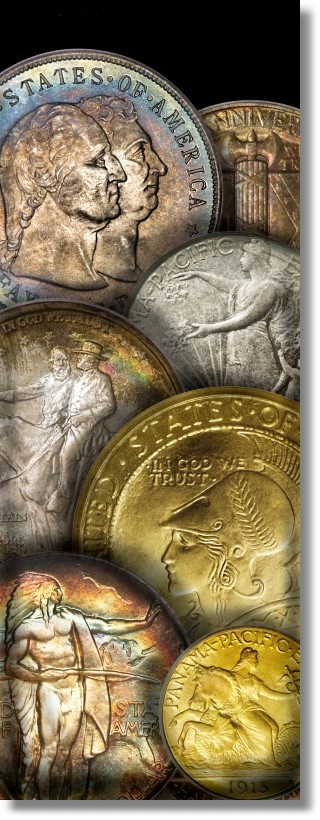U.S. Mint “Early” Commemorative Legal Tender Coins Offer Eye-Catching Investment Potential
By Mark Ferguson for CoinWeek – MFRareCoins.com
Virtually all collectors of rare coins want to ultimately profit from their investment in their collections. Many collectors choose to collect those coins they think have long-term investment potential. And right now “early” United States commemorative coins offer eye-catching potential. These are legal tender coins struck by the United States Mint in commemoration of particular events or people across our nation. The most prevalent of the issues were silver half dollars struck by the U.S. Mint to help raise funds for specific events and places, like the coins issued to raise funds for the Panama-Pacific Exposition held in San Francisco during 1915.
 The marketplace refers to “early” commemorative coins to distinguish the commemorative coins struck between 1892 and 1954 from the “modern” commemoratives, which were struck by the U.S. Mint from 1982 to the present. Most of the early “commems” were silver half dollars, which were struck during the 1930s, but other commemorative half dollars were struck outside that time period. There were also $1, $2.50, and $50 dollar gold coins, and there was the “Isabella” quarter struck in 1892 for the Columbian Exposition, and the Lafayette silver dollar struck for our country’s participation in the 1900 Paris exposition and in conjunction with George Washington’s death.
The marketplace refers to “early” commemorative coins to distinguish the commemorative coins struck between 1892 and 1954 from the “modern” commemoratives, which were struck by the U.S. Mint from 1982 to the present. Most of the early “commems” were silver half dollars, which were struck during the 1930s, but other commemorative half dollars were struck outside that time period. There were also $1, $2.50, and $50 dollar gold coins, and there was the “Isabella” quarter struck in 1892 for the Columbian Exposition, and the Lafayette silver dollar struck for our country’s participation in the 1900 Paris exposition and in conjunction with George Washington’s death.
Mintages of the early commemoratives ranged from just 483 “round” $50 gold coins, struck for the Panama-Pacific Exposition (there were also 645 “octagonal” shaped $50 gold coins) to 2,006,292 silver half dollars struck during 1952 to commemorate and raise funds for the Booker T. Washington Birthplace Memorial and the George Washington Carver National Monument. Very many of these early silver commemorative coin issues had mintages of around just 2,000, 5,000, 10,000 or 20,000 coins, and most were issued in quantities of much less than 100,000 coins. This compares to regular issue United States coins of that period that had mintages of several million coins per issue, and most often into the tens or hundreds of millions of coins per issue per year. One difference is that most of the commemorative coins were kept as souvenirs and didn’t enter circulation, whereas regular issue U.S. coins were destined for circulation in commerce.
I’ve been writing regular columns about the coin market in at least two major influential coin publications for a decade now, and have been a dealer in rare coins since 1969, and during the “go-go” days of the 2000’s for stocks, real estate, and rare coins, the investment focus was off early commemorative coins and on regular issue rare coins intended for commerce. The early commemoratives really didn’t experience the appreciation that other rare coins did during those years, probably because they aren’t as well known. One exception was for really high grade beautiful examples of early commemorative coins with exquisite, colorful toning. Some commems meeting that description were trading for multiples of those without such beautiful toning. Just picking some hypothetical prices, a gorgeously toned MS 66 commemorative half dollar that would have normally been priced for $1,500, may have traded for $5,000 or even much higher, for example!
Over the decades the coin market has experienced many “cycles,” as those with experience refer to market activity within the coin market. These cycles are periods of price appreciation for particular series or areas of coinage, like the “early” Federal issues struck from 1792 to 1836, Barber design coinage, Morgan silver dollars, Saint Gaudens $20 gold coins, early commemoratives, etc. Early commemoratives have had their cycles from time to time, but really haven’t seen an upsurge in activity, except as referenced above, for about 20 years. Many experienced coin dealers across the country have recognized this soft trend for early commems and have begun buying them up and inventorying them. Some are even starting to once again make markets in early commemorative coins. This should be a signal to investors.
Many early commemorative issues are now available for just several hundred dollars each in the Mint State 66 grade. Some will cost a few thousand dollars each. But this is much less than type coins with similar traits that now cost a minimum of several thousand dollars each to tens of thousands of dollars each. There are 144 different mint marked issues of silver commemoratives and just 50 different design types of these silver commemoratives, which is a popular way to collect. There are just 11 different gold commemoratives, not including the two costly $50 Panama-Pacific gold coins. The smaller denomination gold commems now trade for a few thousand dollars each in MS 66.
Mint State 66 is a grade worthy of considering when collecting early commemorative coins with a profit motive in mind. These are “gem” quality coins that are available in the marketplace and are generally appealing to collectors and investors who have money when you want to sell and who will want high end examples. Avoid examples with blotchy or uneven toning, as well as those that have minor imperfections that appear in easy to see places on the coins, like minor hairline scratches or contact marks. Buy only coins with attractive luster, and stay away from those that appear washed out or dull. Experience of having viewed hundreds or thousands of coins is the key to knowing what to look for, even though the coins have been certified by the major grading services. Some certified coins will only just make the grade. You’ll do best with those examples that are solid or high end for a grade.
If you want to take your selection process further, the marketplace values PCGS coins that have been approved and stickered by CAC the highest, although some collectors prefer the white holders produced by NGC. “Plus” grading by PCGS and NGC are appreciated, but they are not being asked for by collectors and dealers as much as CAC stickered coins are. So the market is telling us that PCGS graded coins, stickered by CAC, offer the most appeal to buyers, hence these coins offer the best investment potential.
So far, in this market “cycle,” we’ve seen limited price appreciation in early commemorative coins. However, interest in this area of the coin market has been building among several dealers who’ve begun taking inventory positions in these coins with their own money. This should tell you something. If you have questions, or if I can be of further assistance to you in this area, feel free to call or email me anytime.
 Mark Ferguson was a coin grader for PCGS , a market analyst for Coin Values and has been a coin dealer for more than 40 years. He has written for the ANA, Coin Dealer Newsletter, Coin World, Numismatic News, , Coin Values, The Numismatist and currently has a weekly column on CoinWeek. Mark can be reached at Mark Ferguson Rare Coins ( www.mfrarecoins.com)
Mark Ferguson was a coin grader for PCGS , a market analyst for Coin Values and has been a coin dealer for more than 40 years. He has written for the ANA, Coin Dealer Newsletter, Coin World, Numismatic News, , Coin Values, The Numismatist and currently has a weekly column on CoinWeek. Mark can be reached at Mark Ferguson Rare Coins ( www.mfrarecoins.com)
Inventory Categories
Recent Articles
- Are You a Rare Coin “Collector,” “Collector/Investor,” or “Investor?”
- Four Ways to Benefit by Giving your “Want List” to a Coin Dealer
- Demand is Strong for Most Areas of the Coin Market
- Now May Be a Very Good Time to Invest in Precious Metals
- Discover and Join the American Numismatic Association if you’re not already a Member




